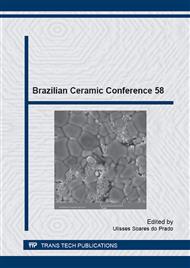p.549
p.553
p.558
p.564
p.570
p.576
p.583
p.588
p.594
Evaluation of the Presence of Aluminum Sulphate Used in the Generation of WTP Sludge when Incorporated to the Clay
Abstract:
The WTPs generate a residue in decanters called sludge, which, despite having a similar chemical composition of clay minerals, does not behave as such when embedded in such clays. Several surveys conducted indicate a decrease in Flexural Strength for the ceramic body when incorporated. The objective of this study is to evaluate the incorporation of the sludge generated at a WTP, which uses aluminum sulfate coagulant, to clay. By the method of pressure casting, samples were prepared with different percentages of sludge containing the said coagulant. Test runs with previously calcined sludge at 700°C were also performed in order to obtain sludge without the coagulant. In both cases, the final bodies were fired at 900°C and were tested for water absorption and flexural strength. The results reveal that the incorporation of non-calcined sludge positively change the quality of the ceramics prepared.
Info:
Periodical:
Pages:
570-575
Citation:
Online since:
June 2015
Authors:
Keywords:
Price:
Сopyright:
© 2015 Trans Tech Publications Ltd. All Rights Reserved
Share:
Citation:


